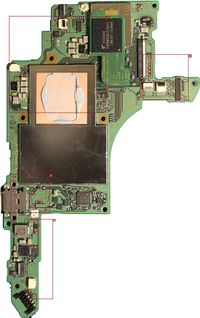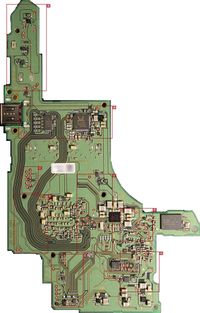Testpads: Difference between revisions
Jump to navigation
Jump to search
SheriffBuck (talk | contribs) |
SheriffBuck (talk | contribs) |
||
| Line 125: | Line 125: | ||
| 2 || GND || || || || || | | 2 || GND || || || || || | ||
|- | |- | ||
| 3 || | | 3 || Rail || DC || 0v8 || || || GPU Buck | ||
|- | |- | ||
| 4 || Vol(+) || || || || || Button Vol (+) | | 4 || Vol(+) || || || || || Button Vol (+) | ||
Revision as of 23:59, 26 January 2022
The Nintendo Switch mainboard has a series of testpads on the front and back, presumably used in factory test, diagnostics, and early board bringup procedures.
Raw Logic captures
These are reference materials, taken from poking at I/O on various testpads. https://github.com/hedgeberg/Switch-Logic-Captures
Photos
Pinouts
Cluster A
| Pad # | Name | Type | Levels | Continuity | Frequency | Comment |
|---|---|---|---|---|---|---|
| 1 | Batt GND? | |||||
| 2 | Battery pulse? | Pulse train | 0-3.3V | L-5? | ||
| 3 | Battery Vdd | |||||
| 4 | Speaker R + | Square wave | 0-3.3V | Speaker Right + | ||
| 5 | Speaker R - | Square wave | 0-3.3V | Speaker Right - | ||
| 6 | Weak GND? | |||||
| 7 | SDA | I2C | 0-1.8V | I2C Port 0 | ||
| 8 | SCL | I2C | 0-1.8V | I2C Port 0 | ||
| 9 | USB-PWR-WAVE? | Square wave | 0-3.3V | K-4, K-5? | ~11 Hz | USB CC2 |
| 10 | USB-PWR-WAVE? | Square wave | 0-3.3V | K-4, K-5? | ~11 Hz | USB CC1 |
Cluster B
| Pad # | Name | Type | Levels | Continuity | Frequency | Comment |
|---|---|---|---|---|---|---|
| 1 | DBVDD | from ALC5639 pin 43 | ||||
| 2 | D+ | USB-C | Cluster B - 3 | |||
| 3 | D- | USB-C | Cluster B - 2 | |||
| 4 | +3.3V | XRST | from M92T36 pin 4 | |||
| 5 | +3.3V | VSVR | from M92T36 pin 6 | |||
| 5(b) | VUSB | VB | from M92T36 pin 9 | |||
| 6 | GND |
Cluster C
The JTAG pins are multiplexed between NV_JTAG and ARM_JTAG by the TRST pin:
- NV_JTAG contains a single TAP (ID 0x221173D7) for boundary scan board verification.
- ARM_JTAG contains two debugging TAPs for CoreSight (ID 0x5BA00477) and BPMP (ID 0x4F1F0F0F).
Note: NV_JTAG and ARM_JTAG are locked out by FUSE_ARM_JTAG_DIS on production devices.
| Pad # | Name | Type | Levels | Continuity | Frequency | Comment |
|---|---|---|---|---|---|---|
| 1 | JTAG_TDI | 0-1.8V | ||||
| 2 | UART1_RX | 0-1.8V | UART-A RX | |||
| 3 | UART1_TX | 0-1.8V | UART-A TX | |||
| 4 | JTAG_TCK | 0-1.8V | ||||
| 5 | JTAG_RTCK | 0-1.8V | Unused for NV_JTAG | |||
| 6 | UART1_RTS | 0-1.8V | UART-A RTS Flow control | |||
| 7 | JTAG_TDO | 0-1.8V | ||||
| 8 | UART1_CTS | 0-1.8V | UART-A CTS Flow control | |||
| 9 | JTAG_TMS | 0-1.8V | ||||
| 10 | JTAG_TRST_N | 0-1.8V | Not a TAP reset; Multiplexes between NV_JTAG (HI) and ARM_JTAG (LO) | |||
| 11 | +1.8V | 0-1.8V |
Cluster D
| Pad # | Name | Type | Levels | Continuity | Frequency | Comment |
|---|---|---|---|---|---|---|
| 1 | GND | |||||
| 4 | Seaker L + | Speaker Left + | ||||
| 5 | Seaker L - | Speaker Left - |
Cluster E
| Pad # | Name | Type | Levels | Continuity | Frequency | Comment |
|---|---|---|---|---|---|---|
| 1 | Vol (-) | Button Vol (-) | ||||
| 10 | Reset | |||||
| 11 | Power Button | Pushbutton | 4V-0V | Active low |
Cluster G
| Pad # | Name | Type | Levels | Continuity | Frequency | Comment |
|---|---|---|---|---|---|---|
| 1 | SD card detect | |||||
| 2 | GND | |||||
| 3 | Rail | DC | 0v8 | GPU Buck | ||
| 4 | Vol(+) | Button Vol (+) | ||||
| 5 | Li-Ion Batt Vdd Mirror | Power Supply | ||||
| 9 | BUTTON_HOME | RCM strap |
Cluster H
| Pad # | Name | Type | Levels | Continuity | Frequency | Comment |
|---|---|---|---|---|---|---|
| 1 | ||||||
| 2 | ||||||
| 3 | ||||||
| 4 | Screen_on | On/Off | 0-1.8v | I-2 | Screen power state, active high | |
| 5 | Flow control | 0-1.8V | I-5 | Flow control for pad I-4? | ||
| 6 | ||||||
| 7 | UART | 0-1.8V | I-4 | 1.5MBaud? | ||
| 8 | UART | 0-1.8V | I-3 | 1.5MBaud? | ||
| 9 | ||||||
| 10 | 5V | H-12 | Power for JoyCon charge circuit and fan | |||
| 11 | Goes to a small ceramic cap near WiFi/BT IC? | |||||
| 12 | H-10 | On the same trace |
Cluster I
| Pad # | Name | Type | Levels | Continuity | Frequency | Comment |
|---|---|---|---|---|---|---|
| 1 | GND | |||||
| 2 | Screen_on | On/Off | 0-1.8V | Screen power state, active high | ||
| 3 | UART | 0-1.8V | 1.5MBaud? | Communication CPU -> Bluetooth using HCI | ||
| 4 | UART | 0-1.8V | 1.5MBaud? | Communication Bluetooth -> CPU using HCI | ||
| 5 | Flow control | 0-1.8V | Flow control for pad I-4? | |||
| 6 | 0-1.8V | Needs testing with chip/touch screen interface board plugged in |
Cluster J
| Pad # | Name | Type | Levels | Continuity | Frequency | Comment |
|---|---|---|---|---|---|---|
| 1 | ? | Edge | 0-1.8V | Turns on around same time as pad J-3 | ||
| 2 | GND | |||||
| 3 | ? | Edge | 0-1.8V | Turns on around same time as pad J-1, slightly after | ||
| 4 | Power button | Pushbutton | 4V-0V | Active low | ||
| 5 | ? | Constant? | 0V | Ground?-NT | ||
| 6 | ? | Edge | 0-1.8V | Turns on with pad J-6, ~1s after J-1/J-3 | ||
| 7 | ? | Edge | 0-1.8V | Turns on with pad J-5, ~1s after J-1/J-3 | ||
| 8 | ? | Edge? | 0-1.8V | Turns on ~1s after J-6/J-7, turns off at unknown point |
Cluster K
| Pad # | Name | Type | Levels | Continuity | Frequency | Comment |
|---|---|---|---|---|---|---|
| 1 | GND | |||||
| 2 | D- | USB-C | Cluster B - 3 | |||
| 3 | D+ | USB-C | Cluster B - 2 | |||
| 4 | USB-PWR-WAVE? | Square wave | 0V-3.3V | A-9, A-10? | ~11 Hz | |
| 5 | USB-PWR-WAVE? | Square wave | 0V-3.3V | A-9, A-10? | ~11 Hz | Appears to mirror K4. Duty cycle 66.67%. Low on screen lock. Off until first interaction. |
| 6 | USB-C V+ | Supply power | support fast charger : "normal mode = 5V+" "Fast changer = 12V+" | |||
| 7 | BQ24193 VBUS + M92T36 VEX | Power supply? | ~3V-0V | None known | N/A | 0 when usb-c not plugged in, falls slowly on first interaction if USB-C plugged in. Power draw related? |
Cluster L
TODO: Update diagram
| Pad # | Name | Type | Levels | Continuity | Frequency | Comment |
|---|---|---|---|---|---|---|
| 1 | Li-Ion Batt Vdd Mirror | Power Supply | Std. Li-Ion | |||
| 2 | GND | |||||
| 3 | Li-Ion Batt Vdd | Battery Input | Std. Li-Ion | |||
| 4 | Mirrored Ground? | Holds steady @ 0, looks like a decoupled isolated ground | ||||
| 5 | Battery pulse? | <1 Hz | Duty cycle ~0% | |||
| 6 | GND |

